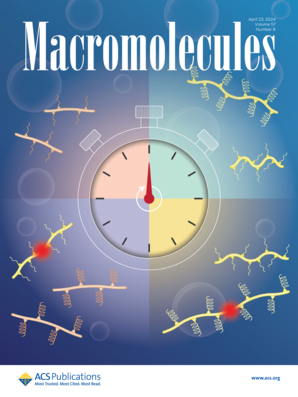Comprehensive Study of the Synergistic Effect in Photocyclic Three-Component Initiating System for Radical Polymerization
IF 5.1
1区 化学
Q1 POLYMER SCIENCE
引用次数: 0
Abstract
In radical photopolymerization, synergistic three-component initiating systems lead to far better radical polymerization performances compared with the corresponding two-component systems. The third component is able to produce additional initiating radicals, regenerate the photoinitiator, thus forming a photocyclic initiating system, and consume terminating photoproducts that occur in two-component photoinitiators. However, the respective roles of these reactions are not well-defined. Kinetic modeling is applied to a synergistic photocyclic initiating system to provide insights into the synergistic effects observed in a system based on an organic dye (Rose Bengal), a triazine derivative, and a tertiary amine as the third component. From kinetic modeling, the low polymerization performances of the dye-triazine system are attributed to back electron transfer but mainly to termination reactions by the oxidized dye photoproduct. Introduction of the amine greatly improves the polymerization performances. From time-resolved experiments, this is explained by its reaction with oxidized Rose Bengal to regenerate the dye and produce additional initiating radicals. It is also shown that the combination of these three components leads to dual photocyclic behavior. Kinetic modeling of the three-component system shows good agreement with the experimental data. Finally, a theoretical study using the kinetic model developed here highlights that the consumption of the oxidized dye terminating agent by the tertiary amine is the main reason for the improved polymerization kinetics.

光环三组分自由基聚合引发体系协同效应的综合研究
在自由基光聚合中,协同三组分引发体系比相应的双组分引发体系具有更好的自由基聚合性能。第三组分能够产生额外的引发自由基,再生光引发剂,从而形成光循环引发系统,并消耗在双组分光引发剂中发生的终止光产物。然而,这些反应各自的作用并没有明确定义。动力学建模应用于协同光循环引发系统,以提供对基于有机染料(孟加拉玫瑰),三嗪衍生物和叔胺作为第三组分的系统中观察到的协同效应的见解。从动力学模型来看,染料-三嗪体系的低聚合性能主要归因于反电子转移,但主要是氧化染料光产物的终止反应。胺的引入大大提高了聚合性能。从时间分辨实验中,这可以解释为它与氧化的孟加拉玫瑰的反应,使染料再生并产生额外的起始自由基。结果还表明,这三种组分的结合导致双光循环行为。三组分体系的动力学模型与实验数据吻合较好。最后,利用本文建立的动力学模型进行的理论研究表明,叔胺对氧化染料终止剂的消耗是聚合动力学改善的主要原因。
本文章由计算机程序翻译,如有差异,请以英文原文为准。
求助全文
约1分钟内获得全文
求助全文
来源期刊

Macromolecules
工程技术-高分子科学
CiteScore
9.30
自引率
16.40%
发文量
942
审稿时长
2 months
期刊介绍:
Macromolecules publishes original, fundamental, and impactful research on all aspects of polymer science. Topics of interest include synthesis (e.g., controlled polymerizations, polymerization catalysis, post polymerization modification, new monomer structures and polymer architectures, and polymerization mechanisms/kinetics analysis); phase behavior, thermodynamics, dynamic, and ordering/disordering phenomena (e.g., self-assembly, gelation, crystallization, solution/melt/solid-state characteristics); structure and properties (e.g., mechanical and rheological properties, surface/interfacial characteristics, electronic and transport properties); new state of the art characterization (e.g., spectroscopy, scattering, microscopy, rheology), simulation (e.g., Monte Carlo, molecular dynamics, multi-scale/coarse-grained modeling), and theoretical methods. Renewable/sustainable polymers, polymer networks, responsive polymers, electro-, magneto- and opto-active macromolecules, inorganic polymers, charge-transporting polymers (ion-containing, semiconducting, and conducting), nanostructured polymers, and polymer composites are also of interest. Typical papers published in Macromolecules showcase important and innovative concepts, experimental methods/observations, and theoretical/computational approaches that demonstrate a fundamental advance in the understanding of polymers.
 求助内容:
求助内容: 应助结果提醒方式:
应助结果提醒方式:


